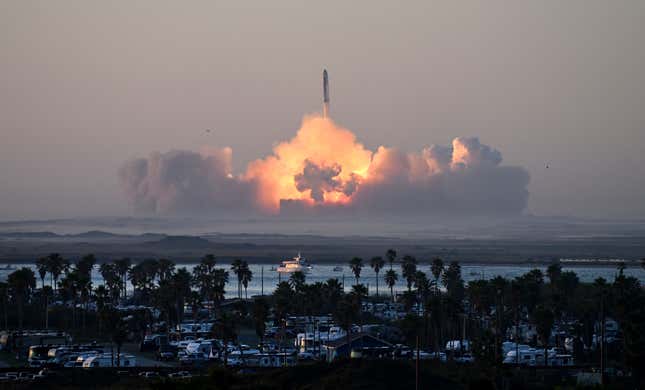
SpaceX launched a test rocket last November that managed to explode twice in the air. That sort of event doesn’t happen every day, so it gave geophysicists a chance to see what exactly that kind of trauma does to the Earth’s atmosphere. The verdict? It’s not great!
SpaceX’s Starship test launch on November 18, 2023, detonated two separate pats of the rocket as it ascended from Earth’s surface. Those two massive explosions allowed scientists from Russia’s Irkutsk Institute of Solar-Terrestrial Physics to get readings from the ionosphere that normally wouldn’t be detectable, giving them new insight into how we’re affecting the world around us. The scientists spoke with TASS, a Russian state news outlet:
According to leading researcher at the Institute of Solar and Terrestrial Physics of the Siberian Branch of the Russian Academy of Sciences, Doctor of Physical and Mathematical Sciences Yuri Yasyukevich, the rocket launch and explosion caused an unexpected response in the ionosphere.
…
According to the scientist, this is the first case of detection of a non-chemical plasma hole formed as a result of a man-made explosion. “Such catastrophic phenomena, such as the explosion of the Starship, are interesting precisely because you can see effects that equipment is not able to detect in weaker events. Analyzing the data and understanding their nature, we understand more deeply the structure of the ionosphere, the nature of the phenomena that occur in it: how charged particles interact with neutral ones, how atypical waves are formed that we observed. All this together works for a very important task – to understand the structure of near-Earth space and use it as a natural detector of processes in various geospheres,” the scientist explained.
The paper published by the scientists calls the pair of explosions a “Man-Made Non-chemical Depletion” referring to the amount of electrons detected in the ionosphere. The depletion, or ionosphere hole created by the detonations, spread across lower North America — though, according to Popular Mechanics, the exact size of the hole is yet to be determined.
Rockets punch through the ionosphere all the time, but it’s rare for a rocket to detonate up there — and rarer still for it to explode twice off one launch. Hopefully, with the information gained from SpaceX’s failure, scientists can better understand how the ionosphere responds to human action. And, maybe, someone can once again build a spaceship that actually works.

